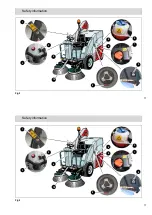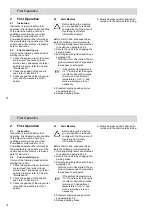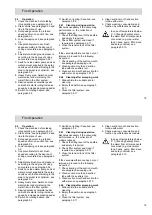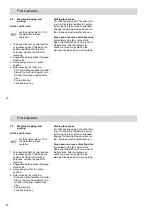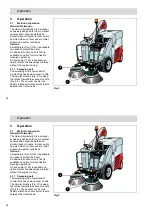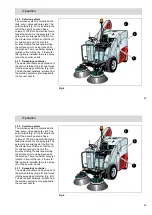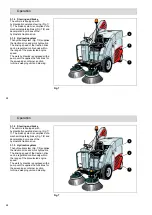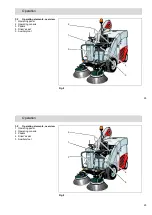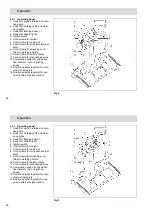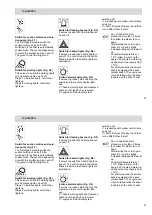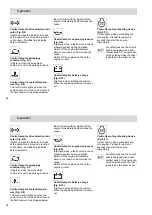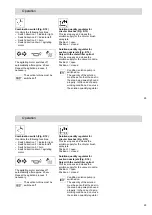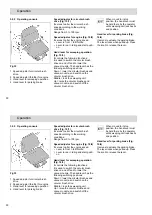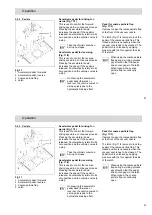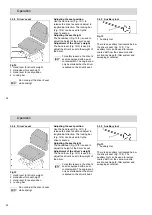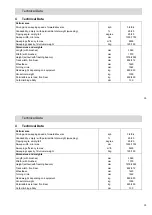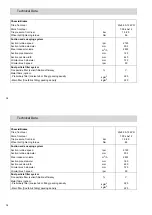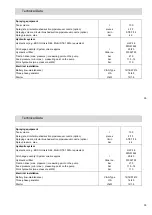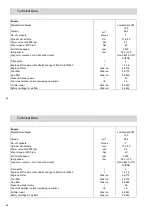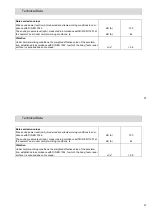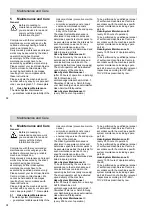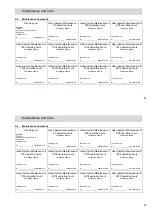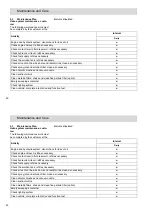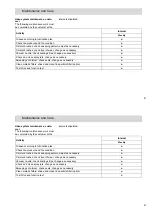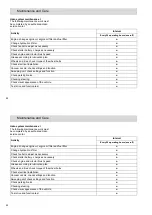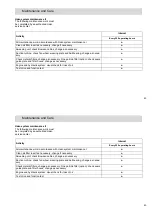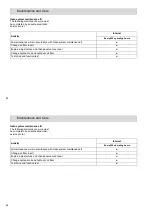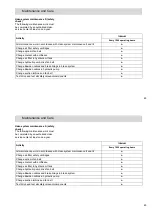
31
Operation
3.2.3 Pedals
Fig.11
1 Accelerator pedal, forwards
2 Accelerator pedal, reverse
3 Coarse particle flap
4 Latch
Accelerator pedal for driving for-
wards (Fig. 11/1)
This is used to control the forward
driving speed in a continuous process.
Pressing the accelerator down
increases the speed. If the pedal is
released, it automatically returns to its
zero position and the vehicle comes to
a stop.
Take the utmost care when
driving on slopes.
Accelerator pedal for reversing
(Fig. 11/2)
This is used to control the reverse
driving speed in a continuous process.
Pressing the accelerator down
increases the speed. If the pedal is
released, it automatically returns to its
zero position and the vehicle comes to
a stop.
On drawing the accelerator
pedal back (forwards or
reverse), the vehicle comes to
a stop quickly due to the
hydrostatic braking effect.
Pedal for coarse particle flap
(Fig. 11/3)
It serves to open the coarse particle flap
at the front of the vacuum nozzle.
The latch (Fig. 11/4)
serves to lock the
pedal of the coarse particle flap. This
locked position is necessary when the
vacuum nozzle has to be cleaned. The
pedal latch is unlocked by applying
pressure with the foot against the side
of the latch.
When using the coarse particle
flap during a working process,
pay attention that the pedal
does not engage in the latch.
When locked, the coarse
particle flap is continually
open.
1
3
2
4
31
Operation
3.2.3 Pedals
Fig.11
1 Accelerator pedal, forwards
2 Accelerator pedal, reverse
3 Coarse particle flap
4 Latch
Accelerator pedal for driving for-
wards (Fig. 11/1)
This is used to control the forward
driving speed in a continuous process.
Pressing the accelerator down
increases the speed. If the pedal is
released, it automatically returns to its
zero position and the vehicle comes to
a stop.
Take the utmost care when
driving on slopes.
Accelerator pedal for reversing
(Fig. 11/2)
This is used to control the reverse
driving speed in a continuous process.
Pressing the accelerator down
increases the speed. If the pedal is
released, it automatically returns to its
zero position and the vehicle comes to
a stop.
On drawing the accelerator
pedal back (forwards or
reverse), the vehicle comes to
a stop quickly due to the
hydrostatic braking effect.
Pedal for coarse particle flap
(Fig. 11/3)
It serves to open the coarse particle flap
at the front of the vacuum nozzle.
The latch (Fig. 11/4)
serves to lock the
pedal of the coarse particle flap. This
locked position is necessary when the
vacuum nozzle has to be cleaned. The
pedal latch is unlocked by applying
pressure with the foot against the side
of the latch.
When using the coarse particle
flap during a working process,
pay attention that the pedal
does not engage in the latch.
When locked, the coarse
particle flap is continually
open.
1
3
2
4

